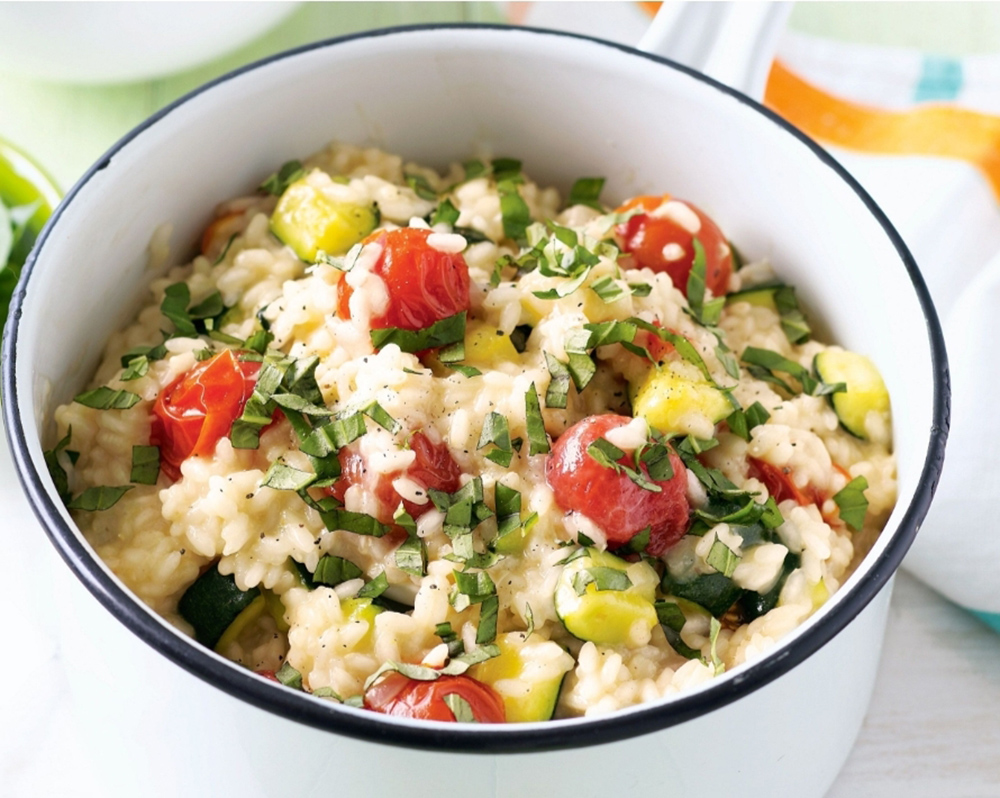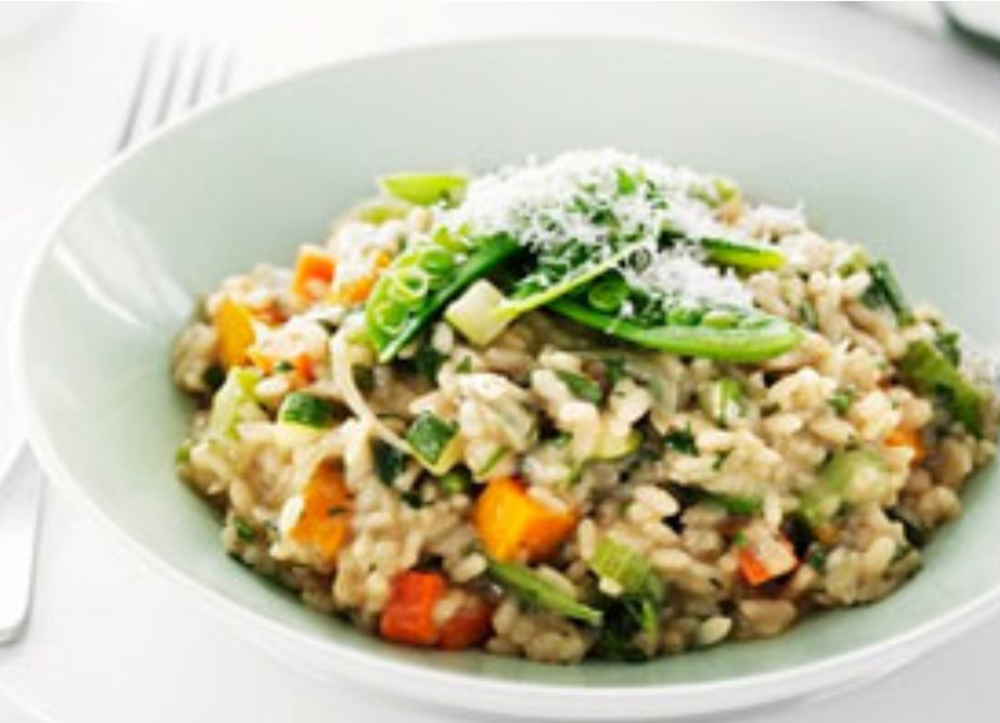My Favorite Italian Rice Dish, Risotto
By Chef Joseph Massaglia

Risotto, the famous northern Italian rice dish cooked with broth (and sometimes red wine like Barolo) until it becomes creamy, is one of the recipe icons of Italian cooking. The name risotto is derived from “riso” meaning rice. The broth can be either meat, fish, vegetable, and most, but not all, risottos contain butter, onions, parmesan cheese and white wine.
By the way, my two favorite risottos are Risotto Tartuflo, risotto with truffles and wild mushrooms finished with a little bit of red wine, and Risotto Zafferano , risotto Milanese style with saffron, finished with white wine.
According to some sources rice was introduced to Sicily by the Moors and Saracens in the 13th century. It moved north and wound up being grown in the Po Valley in the 1400s where it had ideal growing conditions: flat lands, warm weather, water and humidity. In fact, the Po Valley is still one of Europe’s largest producers of rice used in risotto.

Short grain rice with a high starch content is used in making risotto because that rice has the ability to absorb large quantities of liquid while releasing its starch to make a creamy risotto. Carnaroli is the most popular risotto rice used in Italy while in America Arborio is usually used. But other types such as Baldo and Vialone Nano are also used in Italy. And I recently read an article that said you can substitute sushi rice for Carnaroli or Arborio in risotto; I haven’t tried it so I can’t vouch for the outcome.
Although there are many variations of risotto in Italy the traditional method, which involves constant stirring, uses rice that has not been rinsed because you don’t want to remove any starch. You first make a “soffritto” by sautéing onions, garlic, celery and carrots in butter or olive oil; then you add the rice and sauté to briefly coat each grain of rice with a film of fat, which is called “tostatura.”
If you’re using white wine you add that next and cook, stirring constantly, until it has been absorbed by the rice. Then simmering stock is gradually added in small amounts, again while stirring constantly, until all the liquid is absorbed and the rice is rich and creamy – even though no cream has been added. It is the released starch from the rice while stirring that makes it creamy. You then remove it from the heat, stir in butter and Parmesan cheese.
It should be served “al dente” and the traditional texture is “all’onda” or “flowing in waves.” It should easily spread out in a shallow or flat dish, but not have excess liquid spreading around the perimeter.
Probably the most famous risotto dish is Risotto alla Milanese, risotto made with chicken broth and saffron (zafferano), which gives it its rich yellow color. Risotto alla Milanese came about by accident, so one story goes, when saffron being used to color the stained-glass windows in the Duomo in Milan fell into the rice being prepared for the wedding celebrations of the artisan in charge of the work. Other sources say the master glazer purposely added it to match the color of the windows. We’ll never know the true story, but thank goodness this delicious recipe was invented! How would we ever eat Osso Bucco without it?
And you may say, “Joe, Risotto alla Milanese sounds like the rice in Spanish Paella.” And you would be right. Spain ruled Milan for over 170 years in the 1500 and 1600s, hence the Spanish took this presentation back to Spain with them.
At its most simple presentation, risotto is a hearty warming dish, usually served at the beginning of the meal in Northern Italy. Many restaurants in America and around the world add other ingredients to the risotto, which is then typically served as a main course. These ingredients include spring vegetables like peas and asparagus, seafood like lobster, shrimp and crab, mushrooms and even bacon or pancetta.
Chef Massimo Bottura, world-famous Italian restaurateur and chef/owner of Osteria Francescana, a three-Michelin-star restaurant based in Modena, Italy, created a new recipe, Risotto Cacio e Pepe (borrowed from the iconic Roman spaghetti dish), after the earthquakes that devastated the Emilia-Romagna region in May 2012.
Those earthquakes damaged 10 percent of the world’s supply of Parmesan cheese, over 300,000 wheels, and Chef Bottura devised the recipe and sent it out over social media to encourage chefs throughout the world to use the broken pieces of the Parmesan wheels to make this recipe. The recipe was an immediate success, all the cheese was sold, and jobs were saved. You can learn more about his efforts in the Netflix series, “Chef’s Table.” I’ve included his recipe with this article.
Invariably you may have some risotto leftover, and it’s really not as good when reheated. I suggest making Arancini di Riso with it. Arancini, which means orange in Italian, were first made in Sicily and are crispy, deep-fried rice balls, sometimes stuffed with cheese or mushrooms or even eggplant, that are served with a ragu sauce.
Buon Appetito.
Chef Massimo Buttora’s Risotto Cacio e Peppe
Yield: serves 4-6
- 2 lb. Parmigiano Reggiano, coarsely grated to make parmesan broth
- 6 cups parmesan broth
- 1⁄3 cup parmesan cream
- 2 tbsp. unsalted butter
- 3 medium shallots, minced
- 2 cloves garlic, minced
- 2 cups Arborio rice
- Freshly ground black pepper, to taste
- Parsley leaves, for garnish
1 – Make the parmesan broth: Combine parmesan and 81⁄2 cups water in a 6-qt. saucepan over medium-low heat. When the cheese becomes stringy, remove from heat. Let cool to room temperature, and repeat heating once more. Refrigerate broth 8 hours or overnight. The next day, the broth should have separated into 3 distinct layers: a cream layer, on top; a broth layer, in the middle; and solids, on the bottom. Carefully remove the top cream layer and reserve. Strain the broth, discarding remaining solids (bottom layer).
2 – Make the risotto: Heat broth in a 4-qt. saucepan over medium heat; set aside and keep warm. Heat butter in a 6-qt. saucepan over medium heat. Add shallots and garlic to saucepan; cook, stirring, until soft, 3 minutes. Add rice; cook 2 minutes. Add reserved stock 1⁄2 cup at a time, cooking until each addition is absorbed before adding more. Cook, stirring often, until rice is tender and creamy, about 20-22 minutes. Stir in parmesan cream and cracked pepper; garnish with parsley leaves.
* Open Now!! The One and Only Original Mama Mia’s Restaurante in Marmora. www.mamamiasnj.com 609-624-9322
Joe’s Discount Club
* 10% off your wine purchase at Joe Canal’s Discount Liquor Stores – Egg Harbor Township – when you mention Joe’s Table for Two.
* Complimentary wine tasting at Bellview Winery when you mention Joe’s Table for Two.
Joe’s Table for Two radio show airs Saturday mornings from 10 a.m. to 1 p.m. on WOND 1400 AM. Website: joestablefortwo.com. Facebook: Joe’s Table for Two. Contact Joe: joestablefortwo@gmail.com. Joe’s Table for Two radio show airs Saturday mornings from 10 a.m. to 1 p.m. on WOND 1400 AM. Website: joestablefortwo.com. Facebook: Joe’s Table for 2. Contact Joe: joestablefortwo@gmail.com.





